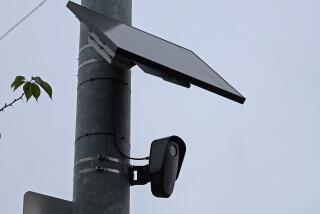Inmates on a Leash : Electronic Units Keep Close Tabs on Felons Serving Time at Home
- Share via
SAN DIEGO — A month ago, Patricia was in Las Colinas women’s jail, serving a year for writing $15,000 in bad checks. She was five months pregnant, could see her children only once a month and was not satisfied with the prenatal care she was getting.
She said it was the worst time of her life.
Now, thanks to a year-old San Diego County Probation Department electronic surveillance program, Patricia, who asked that her real name not be used, is living at her parents’ home in La Mesa and taking care of her two young daughters and 12-year-old son.
Fastened to Patricia’s ankle is a small radio transmitter that lets probation officers keep tabs on her wherever she goes. The transmitter sends a constant signal to a box attached to the telephone that allows a computer to monitor the signal. If Patricia wanders too far from the box, the signal ceases and the computer alerts a probation officer. She is, in effect, under house arrest.
“It’s really very simple . . . . If the radio transmitter goes more than 150 feet from (the box), it calls the computer and says, ‘He’s gone,’ ” probation director Ron Barkett said.
Patricia, 29, is one of 55 people serving the last 10 to 90 days of their sentence “in custody” on the electronic surveillance program. Her husband, who was also convicted of check fraud, has been released on the program. He is allowed to go to work five days a week.
San Diego County’s program is the largest in the nation, and it was the first in California when it was introduced July 1, 1986. Since then, Orange County, the California Youth Authority and the Department of Corrections have initiated similar programs, and officials predict that many others will follow suit.
Electronic surveillance made its Los Angeles County debut on June 13, when slumlord Milton Avol, a Beverly Hills neurosurgeon, started serving a jail sentence in one of his own blighted buildings. Convicted of parole violations, Avol was ordered to live in the building for 30 days, monitored by the first application of electronic surveillance in the county.
Under the sentence, Avol was fitted with an electronic anklet to alert authorities if he strays further than 150 feet from his apartment.
On the larger scale, Los Angeles County will use electronic anklets to supplement Probation Department surveillance rather than as an alternative to incarceration. Under the Probation Department’s Intensive Surveillance Program, the anklets will be used beginning Aug. 3 to monitor up to 20 high-risk probationers, said Sylvia Smith, the county’s chief probation officer.
Under a pilot program funded by a $150,000 grant from the federal Bureau of Justice Assistance, the county will monitor probationers who must either be at work or home as part of pilot program on electronic surveillance, Smith said. The RAND Corp. will evaluate the program, issuing reports periodically over the next 18 months, she said.
Orange County’s system, implemented last October, differs from San Diego’s in that it does not continuously monitor whether the inmate is near the phone. Instead, a computer calls the inmate’s home at random times throughout the day, and the inmate has to fit a tamper-proof, coded wrist band into a box next to the phone.
In San Diego County, nearly 250 people have gone through the program since it started, and officials have declared it an unequivocal success.
For one thing, “it costs the taxpayer nothing,” said Vicki Markey, deputy chief of the Probation Department.
Pays Cost
“The offender pays the entire cost of the program, including the staffing,” she said.
The program saves money for the county because it is cheaper than holding an inmate in a detention facility, Markey said. Most of the people in the electronic surveillance program have served time in a work-furlough facility, where they pay the county $15 a day--about half what it costs to house them.
Those in the electronic surveillance program also pay $15 a day, which covers the entire cost of the program.
Four months ago, the San Diego County Sheriff’s Department began permitting some inmates--none of whom have committed violent crimes and most of whom are women--to enter the program.
The other participants are from the county’s work-furlough program. Normally they would return to a county facility right after work. Now they go home and stay there.
Need Permission
Generally, the only time inmates are permitted to leave their homes is when they must go to the store, the doctor or work, Barkett said. Even then, they have to get permission, and a probation officer sometimes drives to where the inmate said he was going to make sure he actually goes there.
The only snag in the system comes when the computer indicates that an inmate has left his home when in fact he has not. When the computer shows a “false positive,” a probation officer calls the house.
“We sometimes get an irate participant because he gets called two or three times in a night (even though he never left),” said John Weinold, a San Diego County probation officer who helped set up the program.
Most of the people in the electronic surveillance program are serving time for drunk driving, Markey said. All participants are tested for alcohol and drug use at least once a week, and they never know when they might be checked.
If they are found to have used any type of drugs, they are sent back to jail or a work-furlough detention center, and they do not get any credit for having been on the electronic surveillance program.
Kicked Out
About 85% of the participants have completed the electronic surveillance program, Markey said. Some are kicked out after they tamper with the band that attaches the radio transmitter to their leg.
One inmate even tried to slide the band off by greasing it with Vaseline, Barkett said. Most of the time, however, participants pay heed to the warning they get when they begin the program: Do not try to take off the transmitter.
It is easy enough to cut the band loose, Markey said, but it is impossible to refasten, so anyone who tried to get free would be found out when a probation officer came to check up.
Of course, an inmate could leave town, but all of the participants are considered “low risk,” Markey said. Many of them, like Patricia and her husband, are first-time offenders.
About the only criticism of the program has come from hard-line law-and-order types, Markey said.
“There’s a feeling sometimes that it’s not sufficient punishment. Some of the judges . . . feel (electronic surveillance) is not punitive,” she said.
No Cakewalk
But Barkett noted that that “it’s not a cake walk” for the participants. Even though they live at home, they are still “in custody,” she said.
Patricia’s husband, who works as a welder, said that even though “I like (the program) a lot . . . because you get to be with your family,” it is still punitive because “you can’t go nowhere, can’t do what you want to do. It’s like being on work-furlough.”
Times staff writer Craig Quintana in Los Angeles contributed to this story.
More to Read
Sign up for Essential California
The most important California stories and recommendations in your inbox every morning.
You may occasionally receive promotional content from the Los Angeles Times.










